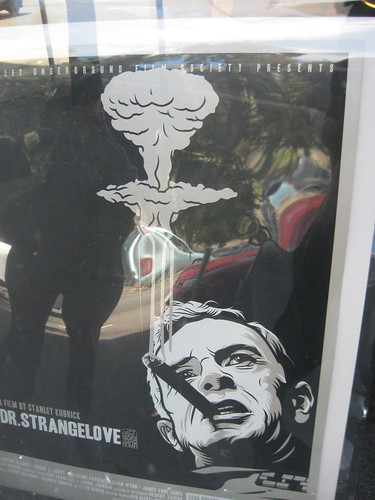9.29.2009
Laser Evolution: Einstein, Townes, Schawlow
>


Here's a little piece on the history of lasers and the predecessor maser at about.com. Among those mentioned, Einstein, Townes, Schawlow, Gould, Maiman, Patel, and Javan.
Labels: gould, javan, laser, maiman, maser, patel, schawlow, townes

9.26.2009
What if Your Parent(s) or Grandparents have Alzheimer's?
>


photo tagged 'old family photo' on the internet
A family history of the Disease is linked to greater prevalence of known genetic markers that act as signposts for Alzheimer's in some cases.
Furthermore, recent investigative research asserts that children whose parents have a history of Alzheimer's Disease are more likely to be an APOE4 allele carrier (46% vs 21%, p < 0.001) than offspring without such a parental history.
Interestingly, plasma apoE levels strongly decreased from APOE2 to APOE3 to APOE4 carrying individuals (p < 0.001), resulting in the finding that reduced plasma levels were associated with higher occurrence of Alzheimer's.
They conclude logically that lower plasma levels in middle age is linked to Alzheimer's in old age, based on a study of 400 individuals, 203 active research subjects and 197 control subjects.
Genetics potentially offers another perspective on solving the cognitive decline puzzle that aids in analysis, or triangulation, of whatever data might be available in a particular case or set of cases, micro or macro.
Labels: alzheimers, apoe, neurology, plasma

9.25.2009
Cognitive Willpower can Be Boosted
>


You only have so much innate willpower, according to scientists who used the classic Stroop exercise to measure, and deplete, the directed mental energy that is required to master tasks from studying to dieting and exercise. [link to Stroop test at U of Michigan]
"Cognitive tasks, as well as emotional tasks such as regulating your emotions, can deplete your self-regulatory capacity to exercise," said study leader Kathleen Martin Ginis, associate professor of kinesiology at McMaster University.
However, you can increase your will through exercise or practice, according to the researchers.
Labels: power, Will, willpower

9.24.2009
Archaeological Breakthrough: Gold, Swords, and Dragons
>


An amateur archaeologist/treasure hunter in England has unearthed a massive 7th century hoard of gold objects, dating to the country's Anglo Saxon period and lying in situ in the kingdom of Mercia, one of the 7 Anglo Saxon wards (from which is obtained the word warden). Mercia in Old English means 'boundary folk' and may refer to those sandwiched between Wales and the main body of Angle and Saxon invaders. You may recall last year's find in Germany, also by someone walking around with a metal detector. The objects include shoulder-fittings for cloaks (as one might see on the Bayeaux tapestry) and gold inlays for swords and shields.
What was the English of the period like? Let's see. Below is the first 20 lines of the Finnsburgh fragment (dated to between 300-700 C.E.) an oral poem...
...nas byrnað?"
Hnæf hleoþrode ða, heaþogeong cyning:
"Ne ðis ne dagað eastan, ne her draca ne fleogeð,
ne her ðisse healle hornas ne byrnað.
5
Ac her forþ berað; fugelas singað,
gylleð græghama, guðwudu hlynneð,
scyld scefte oncwyð. Nu scyneð þes mona
waðol under wolcnum. Nu arisað weadæda
ðe ðisne folces nið fremman willað.
10
Ac onwacnigeað nu, wigend mine,
habbað eowre linda, hicgeaþ on ellen,
winnað on orde, wesað onmode!"
ða aras mænig goldhladen ðegn, gyrde hine his swurde.
ða to dura eodon drihtlice cempan,
15
Sigeferð and Eaha, hyra sword getugon,
and æt oþrum durum Ordlaf and Guþlaf,
and Hengest sylf hwearf him on laste.
ða gyt Garulf Guðere styrde
ðæt he swa freolic feorh forman siþe
in modern English:
from the text
full poem fragment here
The known piece is only about 50 lines long and does not specify which tribes or peoples are involved in a battle, but apparently Hnæf, the person referred to in "Then spoke the young and warlike king", elsewhere known as a Danish prince (in a reference in Beowulf), is attacked at a place called Finnsburuh "Finn's stronghold." According to the context in Beowulf, this is apparently the hall of his brother-in-law Finn, ruler of the Frisians, located on the coast of the present-day Netherlands - where he has come to spend the winter. Hnæf observes that what he sees outside "is not the dawn in the East, nor is it the flight of a dragon, nor are the gables burning". What he sees is the torches of approaching attackers. Hnæf and his sixty retainers hold the doors for five days, without any falling. Then a wounded warrior turns away to talk to his chief (it is not clear on which side) and the fragment ends...the cause of the fight nor the outcome are known.
J.R.R. Tolkien, one of the foremost Anglo-Saxon scholars of his era, wrote a critical review of this fragment and related documents known as Finn and Hengest. With eventually up to 1500 items expected to be recovered, scholars are hoping that this archaeological discovery will revolutionize the understanding of early Medieval English nobility and burial practices and also illuminate the practices of related groups in Northern Europe and Scandinavia.
Labels: angles, Beowulf, finn, finnsburgh, hnaef, mercia, saxons

9.23.2009
First Tiny Elvis, then Tiny T-Rex
>


Just like Elvis once had a tiny understudy, so does T-Rex.
U.S. Palaeontologists with access to a fossil from China have identified a new species of dinosaur, called Raptorex - that was a miniature version of the famed Tyrannosaurus Rex.
The fossil that led to the discovery has a colorful background.

150-lb. Raptorex may have had a distinctive plume
Labels: rapt-r-x, raptorex, tribune, tyrannosaurus

9.22.2009
Alzheimer's Crisis Reaches a Crest
>


Image: the divine wind brings a tsunami to Japan
A new report from Alzheimer's Disease International reports that there are now 35.6 million cases of Alzheimer's and will be 115 million or more by the year 2050.
At this rate, the incidence of the disease will double every twenty years, and this probably underreports the crisis since cases are normally only diagnosed when the patient is in the last stages of what has been an invisible process, possibly commencing decades before it is noticed, along with conditions such as atherosclerosis.
Early detection through screening and other indicators (genetics) and notice of any subtle changes in cognition may act like a version of early radar in the 1940's, giving observers advance notice. Doubtless today's cumbersome process will morph into a sleeker, faster, and more efficient system that will help to save brains and prolong lives.
Undiagnosed Alzheimer's is often a cause of death, since it can lead to cessation of the pulse or breathing as the brain 'forgets' how to regulate these automatic routines, with the disease actually the unlabeled cause of death, rather than the overt symptom or outward manifestation. There is hope, however, in mental, physical, and social activity - in short, staying engaged and 'plugged-in' to the vibe of life and the amazing world around us.
Labels: alzheimers, brain, diagnosis, international

9.21.2009
Brain Size and Aging: New Insights
>

Labels: aging, artificial life, brain

9.19.2009
Tomorrow is Today
>


In a way, the innovation is reminiscent of the dagguerotype, a process first invented in 1839 by the scientist Daguerre, that same year John Herschel (descendant of William Herschel) was the first to use the word "photography."

the first American daguerrotype
Interestingly, the ability to take a picture dates back to 1000 and the Arab natural philosopher Ibn Al-Haytham, born in the city of Basra who introduced the sun camera, or camera obscura-also the name of a band. al-Haytham wrote the first important treatise on Optical systems, called "Book of Optics" (often considered the second most important early work on physics after Newton's Principia) and sketched the behavior of rays of light through a pinhole as is represented below. Amongst Medieval thinkers he was often called Ptolemaeus Secundus, or Ptolemy the Second, after the famous Alexandrian scientist of antiquity, Claudius Ptolemy, since he, like Ptolemy, conducted scientific work for patrons who were the rulers of Egypt.
rays of light and Arabic characters
The researcher's experimentation in itself reawakened concepts outlined in the 4th century B.C.E. by the philosopher Aristotle, Alexander the Great's tutor, incidentally.

Illustration of a camera obscura in use, Italy.
Labels: al-haytham, daguerrotype

9.17.2009
Scientists: Iran May Be Ready to Join Nukular Club
>


Uh-oh.
Scientists from the U.N. are asserting that Iran is on the cusp of joining the coterie of nations with the wherewithal and gumption [and capacity for strategic thought] to produce nukes.
Labels: gumption, hayden, iran, kubrick, nuclear, nukes, nukular, sterling, strangelove

9.16.2009
Intelligence & Curiousity
>

Labels: curiousity, intelligence

I Want my Magazine-online
>


A new way to experience magazines is here. For almost a decade since inquisitors like Michael Wolff popped the balloon of big media in exposes starting with Burn Rate, moguls have been striving to recreate the deliciousness of the print experience as exemplified in an ad-feature spread in mags like Vanity Fair in an online hybrid. Companies like zinio strove to fill this gap.
Now, this is accomplished with Flip (as above).

9.15.2009
Cheap Edge-of-space Flight Redux
>

9.14.2009
Brainfreeze: do we have too much government?
>

As food for thought, consider that the rise, flourishing, and fall of the telegraph has occurred completely within the growing time of the tree of government.

A system conceived to link vast distances and replace arduous post

Health and Gov'mint
>

Despite all the good intentions - the gap between care received and the national infrastructure; including health systems, insurers, eligibility rules, and intangibles such as attitude toward things like wellness, diet, and exercise across the country - continues to grow.
Why is it that with escalating cost and specialization that the benefits of the investment are elusive, like balls of mercury slipping away between the fingers?
An interesting phenomenon which has occurred simultaneously with the run-up in expense is the explosion of knowledge available to the interested layperson. How many people have faced illness amongst family and friends, learned about the basic condition from the specialist - then researched the condition ad nauseum on the Internet and so became equipped to interrogate the specialist on a return visit, citing the latest journal articles which the burdened physician may not have had the time to read yet. Some professionals enjoy the challenge (when they have the time to spend with the patient) while others do not appreciate being second-guessed or called out.
On the one hand, the system as a totality is close to the breaking point; on the other hand, the ability of the individual to compile background information on the topic continues to grow. A potential solution is to see the knowledge repository as the first line of medical information, able to provide self-help. Layers of information experts or agents could provide a second line of intervention and simple diagnostics, deferring other cases to a third layer staffed by humans equipped with tools to investigate the individual's case. A fourth layer of specialists focusing on specific conditions could exist anywhere in the world and perform laboratory diagnostics; a fifth layer of experts could exist locally and provide surgical services to individuals in a given region, linked to recovery services. The structure would resemble a pyramidal hierarchy of need, mitigated by technology, and of course individuals and the experts both would have access to their personal electronic records. In terms of cost-management, individuals could earn points or credits by using the automated information systems (which could be free) and spend the credits when they needed to see an expert. In this way, individuals could be incented to manage their own health and maintain wellness, which would act as a deterrent to illness, without paying for insurance and then being spammed by insurers to discourage use of the services already paid for.
Labels: government, insurance, tortuous

9.10.2009
Antihypertensive Therapy may Slow Cognitive Decline
>

Labels: hypertension, therapy

Achilles' Heel
>

Labels: heel

9.09.2009
Jim Thorpe, World's Greatest Athlete
>

This independent film (2009), which premiered at the famed Pacific Film Archive - has been picked up by PBS and will air this Fall. Nephew Kerrigan Addicott edited and executed a variety of behind-the-scenes production responsibilities, outstanding for a 17-year old. The first film we ever witnessed at PFA was Ashes and Diamonds, directed by Wajda - favored as a classic of B&W technique, via the interplay of light and shadow.
Labels: addicott, archive, film, thorpe

9.08.2009
The Nines and Pythagoras
>

If so, blame it on Pythagoras, who created not only the famous theorem (a2 + b2 = c2) but also numerology.

Pythagoras reputedly learned his knowledge of geometry from Egyptian priests or perhaps, the oracle of Delphi.
Labels: pythagoras

9.07.2009
Saturated Fat and Alzheimer's Causality
>


Researchers believe they have discovered why foods high in saturated fat increase the likelihood of developing Alzheimer's disease.
Researchers from Curtin University of Technology in Perth, found that saturated dietary fat damages the lining of blood vessels in the brains of mice, allowing a protein called amyloid to enter the brain.
The study, to be published in the British Journal of Nutrition, is one of the first to demonstrate a scientific link between diet and Alzheimer's disease.
"In the past population studies suggested that high fat diets may be a risk factor for Alzheimer's disease, but no one really understood why," says Professor Mamo, co-author of the study and National Director of the Australian Technology Network's Centre for Metabolic Fitness.
More >>
Labels: alzheimers, fat, saturated

09 Burning Man
>

2009 Burning man test...image by Frederic Larson from sfgate.com
Labels: burning, larson, man, sfgate.com, test

your Base
>


hold the pickles and lettuce...here's the real pic...

9.06.2009
Additional Alzheimer's Disease Gene Associations
>

Labels: alzheimers, apoe, CR1, genes

test
>

Smell of Space vis-a-vis Space.com
>

9.04.2009
SOS
>

How about SOS?
(S)ave (O)ur (S)entience.
Throw your brain a life preserver by staying mentally fit.
Labels: sos



